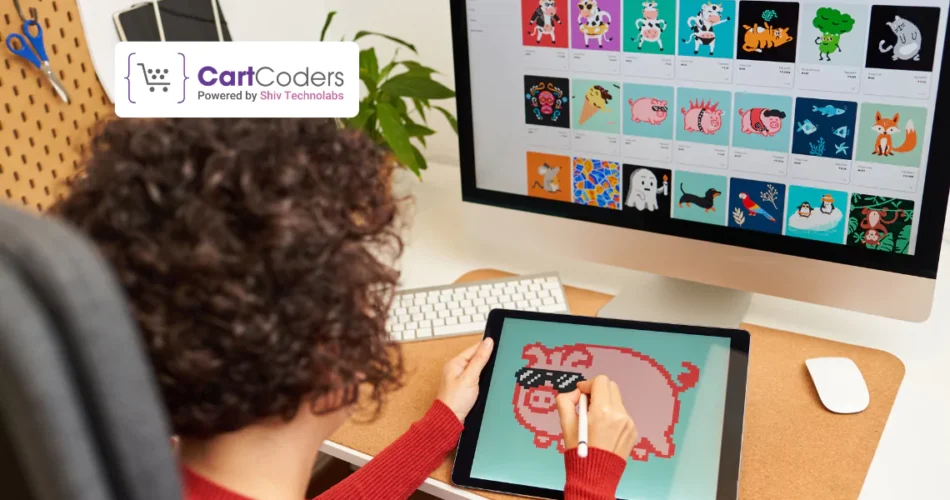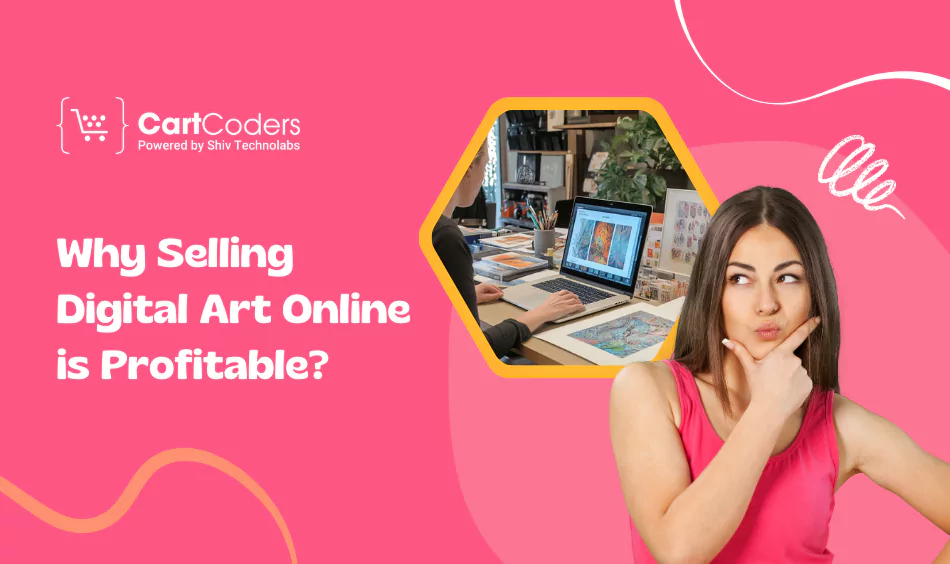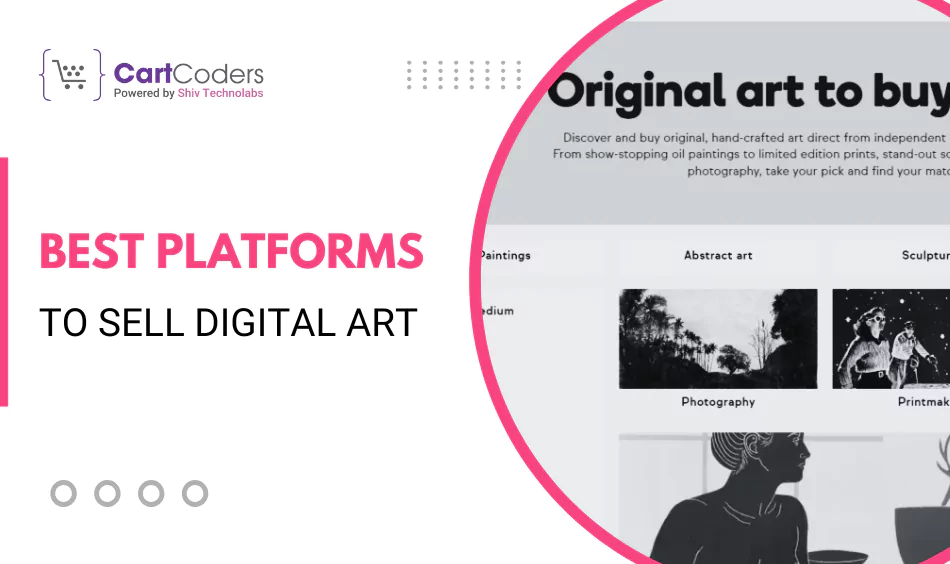Custom Engagement Solutions
Unlock tailored solutions with a free, no-obligation strategy session.
Expert Developers & Engineers on Demand
Scale Your Team with Skilled IT Professionals
Expert Guidance for Digital Transformation

Ever wondered, how to sell digital art online and make money on a regular basis? This blog has your answer.
Do you know? The digital art industry is booming like anything. Whether you create illustrations, digital paintings, or 3D assets, selling your art online is no longer just an option, it’s essential. Digital art sales grew rapidly during the pandemic, but have since seen a modest downturn.
While they once approached $13 billion, the most recent data shows they reached $10.5 billion in 2024, still significantly higher, about 76% of pre-pandemic levels.
But how do you take advantage of this trend and turn your creativity into income? This blog will walk you through the steps: from choosing platforms to creating your own website and marketing your art effectively.
Digital art is any artwork created or presented using digital technology. Instead of traditional tools like canvas, brushes, or physical materials, artists use digital tools and software to produce their work. These pieces can be displayed on screens, printed, or distributed as downloadable files.

Let’s clear the biggest doubt—is it worth it?
Yes, absolutely. Here are a few reasons why digital art is one of the most lucrative segments of the creative economy:
According to Grand View Research, the global online art market was valued at USD 11.09 billion in 2024 and is expected to expand to USD 19.25 billion by 2033, reflecting a 6.3% compound annual growth rate (CAGR) from 2025 to 2033.
Selling digital art online is an excellent way to turn your creativity into revenue, but it requires a structured approach. These 12 steps will guide you from preparation to promotion.
Start by choosing a specific niche. This makes marketing easier and attracts a focused audience. Examples include:
A defined niche establishes your identity and helps you target buyers effectively.
Use professional tools such as Adobe Photoshop, Illustrator, or Procreate to create your artwork. Save your files in high resolution (300 DPI for print) and provide multiple formats like JPEG, PNG, or PDF.
Ensure the files are organized and ready for instant download.
There are two main routes:
For long-term success, building your own store is the smarter choice.
Shopify is a powerful platform for selling digital products. Here’s how to set up your store:
A clean, image-driven design makes your artwork the focal point.
Upload your digital art to Shopify:
Shopify doesn’t provide built-in digital delivery, so install apps such as:
Configure these apps to deliver files instantly after purchase. Always test the process before launch.
Clarify usage rights to avoid disputes. Common options include:
Create a dedicated Licensing Policy page and summarize key terms in each product description.
Enable multiple secure payment options to reach global buyers. Shopify supports:
Offering multiple options increases trust and convenience for your customers.
Pricing should reflect time, complexity, and market value. Research similar products on marketplaces like Etsy. Consider tiered pricing:
Pricing tiers allow you to serve hobbyists and commercial buyers.
SEO is critical for organic traffic. Implement these strategies:
Check out our Shopify SEO services now!
Your website alone won’t bring traffic. Use marketing strategies to attract buyers:
Building a presence across platforms ensures consistent traffic.
Repeat buyers are your most valuable customers. Build loyalty by:
A strong relationship encourages repeat sales and positive word-of-mouth.

Selling digital art online is easier than ever, thanks to multiple platforms catering to different needs. Whether you want to start small or build a full-fledged store, here are the top platforms to consider:
Shopify is the best choice for artists who want full control over their business. Unlike marketplaces, Shopify allows you to own your brand, customize your website, and keep 100% of the profits.
Why choose Shopify?
Ideal for: Artists serious about creating their own online store and building long-term revenue.
One of the most popular platforms for digital and printable art.
Great for turning your designs into products like T-shirts, mugs, and stickers.
Perfect for professional illustrators and concept artists.
A well-known community platform for artists.
✅ Pro Tip: Start by listing your art on one or two marketplaces for exposure, then move to Shopify to build your brand and maximize profits.
Earning income from digital art isn’t just about creating great designs—it’s about choosing the right strategy and platform. Here are the most effective ways to turn your artwork into a steady revenue stream:
Platforms like Etsy, Redbubble, and ArtStation allow artists to list digital files for instant downloads.
These sites already have large audiences, so you can start selling quickly. However, they charge fees and offer limited control over branding.
Owning your website gives you complete control over pricing, branding, and customer relationships. With Shopify, you can:
This approach eliminates third-party commissions and helps you build a recognizable brand.
Many buyers seek personalized designs. Promote custom art services alongside your digital downloads. This adds a premium income stream and builds loyal clients.
Sell your designs for commercial use in marketing campaigns, products, or branding. Offer tiered licenses—personal use, commercial use, and extended commercial—to maximize revenue.
Convert your digital art into physical products like prints, T-shirts, or mugs using print-on-demand services. Integrate these options into your Shopify store for an extra income channel.
Use social media platforms like Instagram and Pinterest to showcase your work. Create email campaigns to keep your audience engaged. Combine organic content with targeted ads to boost sales.
Imagine building a community around your art, controlling pricing, and keeping 100% of your revenue. That’s what happens when you create your own website.
With a custom site:
Plus, search engines can drive organic traffic to your store—something you can’t achieve with marketplaces.
Building a digital art store is more than just uploading designs. It requires a well-structured platform that delivers an exceptional buying experience while ensuring your files remain secure. This is where CartCoders comes in.
We specialize in art & craft website development services tailored for digital artists. Our team ensures:
Whether you’re an independent artist or running a creative studio, we help you take complete control of your brand and maximize profits.
Selling digital art online is no longer a side hustle; it’s a serious business opportunity. The global demand for digital downloads, printable designs, and online art solutions continues to rise, making this the perfect time to start.
By following the 12 steps outlined in this guide—choosing your niche, setting up a professional store, integrating instant downloads, and promoting effectively—you can turn your passion into a consistent income stream.
While marketplaces like Etsy or Redbubble offer a starting point, your own Shopify-powered website gives you full control, better profit margins, and the chance to build a recognizable brand.
If you’re ready to move beyond third-party platforms and create a professional digital art store, CartCoders is here to help. Our expertise in Shopify development services ensures that your store is secure, scalable, and designed to convert visitors into buyers.
Take the first step toward building your digital art business today. Contact us today!
Projects delivered in 15+ industries.
95% retention rate, building lasting partnerships.
Serving clients across 25+ countries.
60+ pros | 10+ years of experience.